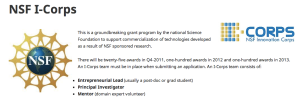Good piece by Sam Petulla highlighting the recent Association of University Technology Managers survey on technology commercialization at select universities in America. Decent growth given overall higher education and economic trends. Good charts in the full piece. From Inside Higher Education:
Although economic growth stagnated in 2009, a new survey says scientific research from about 150 universities created 555 startup companies and resulted in over 4,500 patent optioning and licensing deals last year, earning $1.8 billion in payouts for the institutions in the process. The numbers continue a decade-long trend of the increased role of universities in generating commercial products for businesses.
“Technology transfer” — as the process of universities commercializing their findings is known — allows businesses to turn the fruits of academic research into new technologies, such as new drugs and energy-saving products. In return, universities collect licensing fees or royalties, or a partial ownership stake in a product. Universities also typically have a small staff dedicated to brokering deals on hand — not an insignificant source of employment itself.
Technology transfer offices still garner a lot of attention and resources, but did they play a role in Facebook, Google, H-P, Under Armour, Gatorade, and Groupon? Does anyone have any evidence on any of these?
(I have read Rovell’s book on Gatorade — First in Thirst — so I do know the University of Florida did not really want anything to do with the creation of the drink in the early years. When it became worth hundreds of millions, the lawsuits began. )
It appears the full survey is only available for purchase. So, there are some news stories and press releases out there. For example, a Dec. 20, University of Utah press release based on the survey: “U of Utah: No. 1 for Startups, Overtakes MIT in Number of Spinoff Companies.”
The IPWatchDog blog has a nice look at the piece including some good charts on tops universities and hospitals in terms of funding and commercialization of technology. Some good information on the survey and trends from Gene Quinn at IPWatchDog, Inc.:
In terms of mechanics, the 2009 AUTM survey was sent to 322 U.S. institutions, which is up 12 from 310 U.S. institutions that were contacted in FY2008. Of the 322 U.S. Institutions contacted 249 were universities and colleges, 69 were U.S. hospitals and research institutions, and four were third-party patent management and investment firms. The response rate was 56.2 percent, which included 153 U.S. universities, 27 U.S. hospitals and research institutions, and one third-party patent management and investment firm.
In 2009, 181 institutions reported 20,309 disclosures, an increase of 194 (0.96 percent) compared with the 20,115 disclosures from 189 institutions in 2008. This marked an uninterrupted trend of annual increases in total disclosures since 2000.
I’d love to show you some of IPWatchDog’s great charts, etc., but given the name of the site I’d guess they wouldn’t want me to do that (or would they bow to the ethos of the internet — I have already provided multiple links to their site).
Either way, there is some good stuff out there on the latest AUTM survey and they are worth exploring.
via News: Universities Gain from Licensing Activity – Inside Higher Ed.
 been pleasantly surprised by its growth and expanding reach. GWU, University of Maryland and Virginia Tech have taken the lead in our region (the DC I-Corps) and have some great people working on the program. I came across a piece from Stephanie Baum at Med City News highlighting some of the innovative teams and projects taking part. From Baum,
been pleasantly surprised by its growth and expanding reach. GWU, University of Maryland and Virginia Tech have taken the lead in our region (the DC I-Corps) and have some great people working on the program. I came across a piece from Stephanie Baum at Med City News highlighting some of the innovative teams and projects taking part. From Baum,